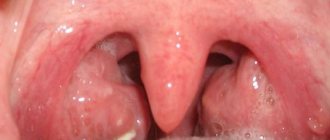A high body temperature along with a sore throat is an unambiguous sign of an infectious disease or acute respiratory infection, more often of a viral or bacterial origin. A change in body temperature can be of the type of hyperthermia, that is, its actual increase, or it can manifest itself as a fever, which is already a complex symptom, including not only a change in thermometer readings, but also a feeling of heat or chills, weakness, thirst, etc.
It should be noted that the normal temperature in adults and children over one year old is considered to be 36.6 - 36.9 degrees. A temperature of 37-38 is called subfebrile, 38-41 is febrile (from “febris”, which means “fever”), and above 41 is hyperthermic. The numbers on the thermometer not only tell us the very fact of the presence of a high temperature, but often serve as an indicator of the severity of the disease and its dynamics.
Hyperthermia - benefits and harm to the body
Whatever is accompanied by acute respiratory infections, hyperthermia or fever, an increase in temperature carries both benefit and harm to the body. And sometimes it can be very difficult to determine what is more from hyperthermia (harm or benefit), and to understand whether the high temperature needs to be brought down or not. So, what are the benefits of fever:
- Firstly, our body, by raising its own temperature, creates uncomfortable conditions for the proliferation of microbes.
- Secondly, it is high body temperature (above 37 degrees) that is a signal for the body to produce interferon, a specific antiviral protein.
- Thirdly, hyperthermia stimulates the work of local immunity, thus enhancing the fight against bacteria.
An increase in temperature and fever are often accompanied by loss of appetite and restriction of the movements of a sick person, but even these, at first glance, not very pleasant phenomena, have their advantages for the body.
During illnesses, strength is primarily needed to fight infection, and not to digest. Forced restriction of physical activity also saves energy and, in addition, reduces the chances of the sick person getting some kind of complication after the illness.
But if the throat is red and sore, and in addition there is a very high temperature (39 degrees or higher), a person, in addition to physical discomfort, may experience the consequences of the harmful effects of fever, namely:
- The overall health is difficult, because with high levels of hyperthermia, it is not only painful to swallow, and the red throat itself bothers you, but also a headache, aching body, and throwing you either hot or cold.
- Loss of fluid, which the body especially needs during illness, because it is needed both to remove harmful substances from the body and for the functioning of local immunity. Lack of fluid can seriously affect the severity and duration of the disease.
- Increased cell demand for oxygen.
- In children under 5 years of age, fever can provoke the development of seizures against a background of high temperature (“febrile seizures”).
Naturally, it is necessary to treat first of all the disease that caused the increase in temperature indicators. But often the patient requires symptomatic help - taking antipyretics (paracetamol, ibuprofen, nimesil, aspirin), especially when hyperthermia greatly affects general well-being.
Diagnostics
If you experience a sore throat, you should consult a therapist or a specialist - an otolaryngologist. For these symptoms, laboratory and instrumental examination methods are used. In most cases, it is either possible to find out the cause of symptoms before receiving test results, or treatment is selected empirically. This is due to the need to wait.
When collecting anamnesis, the rate of temperature rise, the nature of sensations, and previous circumstances are taken into account. During the initial examination, signs of pharyngitis or tonsillitis are most often revealed. The doctor pays attention to the presence of mucous discharge or pus on the back wall of the pharynx, the uniformity of inflammation, swelling, redness, the presence of hypertrophied follicles and a number of other details.
Instrumental diagnostic methods include laryngoscopy. The method is used if the doctor has not detected external changes in the pharynx area. When examining the larynx, a number of diseases can be identified: laryngitis, malignant tumors. During laryngoscopy, a specialist conducts an examination using a special probe and a small video camera.
If a sore throat occurs, it is most often necessary to take a general blood test and swabs from the throat and nose. Recent studies are helping to establish the strain of pathogens and identify their sensitivity to various drugs. A general blood test allows you to exclude systemic diseases. In most cases, indicators indicate the presence of an inflammatory process. There is an increase in the concentration of leukocytes and an increase in ESR.
In order for a red throat to stop hurting, it is necessary to identify what causes this condition. For this purpose, the ENT interviewes the patient, listens to his respiratory tract and performs pharyngoscopy.
In this case, a smear is often taken from the throat to study the microflora and determine the sensitivity of bacteria to a particular group of antibiotics. Additional diagnostic methods include measuring the concentration of hydrochloric acid in the esophagus, X-rays of the neck and chest.
First of all, the patient should not overstrain the inflamed ligaments. So, he needs to talk less, not smoke and drink plenty of fluids, which will soften his throat. In addition to antiseptic rinses, you can dissolve lozenges that have an antibacterial effect and take antitussive lozenges.
Symptoms that require immediate attention to an ENT specialist include:
- labored breathing;
- red throat, accompanied by severe pain;
- dizziness;
- high temperature (39-40 degrees);
- vomit;
- cough;
- nausea;
- abdominal discomfort.
We suggest you read: When can you wash after tooth extraction?
Hygiene after tooth extraction The diet for sore throat, pharyngitis and other throat diseases should be gentle. So, during the illness you should avoid salty, sour, pepper and hot foods. Priority should be dairy products - yoghurt, kefir, porridge.
In addition, do not forget about warm drinks, thanks to which you can remove intoxication, prevent dehydration and remove toxins from the body. Therefore, it is useful to supplement drug treatment with the use of fruit drinks, warm mineral water, tea, compotes and infusions.
Warm drinks help stimulate blood circulation in the throat, they soften it, relieving soreness and dryness. It is better to avoid alcoholic, carbonated, hot or cold drinks.
Treatment with drugs
A red, sore throat should be treated by gargling with disinfectant solutions such as Furacilin, Chlorophyllipt and Chlorhexidine. In addition, solutions of iodine, soda and salt can be used every 2 hours. And to soften the mucous membrane, it is recommended to rinse with a solution of hydrogen peroxide (3%), which also has a bactericidal effect.
In addition, comprehensive treatment of a sore throat is carried out. For this purpose, anti-inflammatory and antimicrobial sprays are used - Hexoral, Cameton, Yox.
To get rid of a sore throat or pharyngitis, the doctor prescribes sprays such as Bioparox, Tantum Verde or Miramistin. However, before treating a red throat with such means, you need to make sure that their components do not cause an allergic reaction.
In addition, patients need to dissolve lozenges and lozenges - Falimint, Septolete and Strepsils. Corticosteroids and antihistamines (Zodak, Zyrtec) can also be prescribed, which help relieve inflammation, pain, redness and swelling.
A red throat can be treated with physiotherapy. Thus, aerosol therapy is a gentle and effective method that has a strong analgesic effect.
Inhalations with the addition of essential extracts, herbal infusions and ultrasonic inhalations with saline or mineral water effectively eliminate unproductive cough, soften the mucous membrane and facilitate the functioning of the respiratory organs.
In addition, a sore throat can be treated with vibroacoustic effects and magnetotherapy. These procedures normalize microcirculation and improve innervation and trophism.
Moreover, with their help you can remove congestion and activate the influx of leukocytes that localize pathogenic microflora. This treatment helps strengthen the immune system, relieve pain and eliminate the inflammatory process.
In addition, it is useful to use a laser on inflamed tonsils and the back wall of the pharynx. This procedure is very effective, using a special tip through which the laser beam affects the problem area. It is worth noting that the impact can be internal or external.
Connection with diseases
As you already understand, if a person’s throat is red, sore, and accompanied by an increase in temperature, then this indicates that he has received a viral or bacterial infectious disease. Depending on where the harmful microbe “settled” and multiplied, that is, caused inflammation, it is customary to distinguish the following pathologies:
- Tonsillitis,
- Laryngitis,
- Pharyngitis.
With tonsillitis, the target of microbes is the tonsils (tonsils) - paired organs that are located in the pharynx - between the oral cavity and pharynx.
When tonsillitis is caused by viruses (for example, adenoviruses), the patient complains that it hurts to swallow, that he has a headache and is worried about weakness in the body, and the thermometer shows from 37 to 39 degrees.
When examining the throat, it is clear that it is red in the area of the pharynx and the tonsils themselves, which are also swollen, but, mind you, free from any purulent plaque. Also, with viral tonsillitis, there may well be a runny nose and a slight cough, as a result of mucus flowing from the nasal cavity into the throat and irritation of its walls.
Read on to learn about the symptoms and how to treat viral sore throat.
My head and throat hurt and my temperature is 38, what should I do?
If a temperature of 38° is determined and an adult or child has a sore throat, then we are talking about a cold. This is what people call such diseases. Doctors divide pathologies into viral, bacterial, allergic, fungal, and so on.
In each case, an individual treatment is chosen, which will not help in another situation. Today’s article will tell you about the reasons why your temperature rises (38°) and your throat hurts. What to do in each situation will be described below.
Please note that the information presented does not encourage you to self-medicate. If you have a fever and discomfort in the larynx, you should definitely see a doctor.
Infectious mononucleosis
A specific disease affecting the tonsils by viruses is infectious mononucleosis. Its signs:
- Headache, aching muscles, joints, weakness,
- Swallowing hurts (symptoms of sore throat),
- The lymph nodes of the neck are enlarged, painful,
- The liver and spleen enlarge.
Fever with this disease has a wave-like character, which means that the temperature either rises to 39-40 degrees, then drops to 37-38 or even to normal levels. Fever may bother the patient for a week to three.
A cough may also periodically appear - a symptom of damage to the trachea or large bronchi, as well as a specific herpetic rash on the skin of the lips. During infectious mononucleosis, a runny nose may periodically bother you, which, however, is not a characteristic symptom of this disease. A runny nose is a symptom of a parallel acute respiratory viral infection, to which a patient with mononucleosis becomes very sensitive.
The disease must be treated symptomatically, since specific therapy has not yet been developed. That is, when a fever bothers you, you need to give the patient antipyretic drugs, a runny nose - vasoconstrictor drops, etc. It is also recommended to limit physical activity during illness and drink plenty of fluids.
Angina
Bacterial tonsillitis is better known as tonsillitis. This disease often occurs acutely, namely with a sharp increase in temperature to 38-39 degrees, and also because the patient’s throat becomes sharply red, the tonsils increase in size, and it is very painful for a person to even swallow saliva.
The groups of lymph nodes closest to the tonsils also become painful and enlarged. There is no runny nose or cough. A cough can occur only if inflammation spreads to the organ adjacent to the pharynx and tonsils - the pharynx, that is, if there is concomitant pharyngitis.
| Hyperthermia with sore throat | ||
| Type of sore throat | Distinctive symptom | Body temperature |
| Catarrhal | All signs of inflammation of the tonsils (red throat, painful to swallow, enlarged tonsils) in the absence of purulent plaque on them. | 37-38 |
| Follicular | Under the mucous membrane of the tonsils, yellow dots (tubercles, elevations) are visible - accumulation of pus in the follicles. Swallowing drinks and saliva is so painful that the pain can radiate into the ear. | Up to 39 |
| Lacunarnaya | On the surface of the tonsils there are plaques, plugs in the depressions (lacunae), which are purulent in nature. | 39 (in some cases - 40) |
| Fibrinous | The inflamed tonsils are covered with a continuous purulent film. | 39-40 |
| Phlegmonous | The head and throat hurt very much, swallowing saliva and talking are also very painful, one tonsil is sharply enlarged, looks like a red spherical protrusion into the cavity of the pharynx. | 39-40 |
| Ulcerative-necrotic | One tonsil is slightly enlarged; there are mildly painful ulcers on its surface, the bottom of which is covered with a gray coating. | Normal or 37-38 degrees. |
To treat a sore throat you need to use antibiotics, and which ones, read our article about antibacterial therapy for acute tonsillitis. How else can this disease be treated, you can find out in the article: how to quickly cure purulent sore throat in an adult?
There is a disease - scarlet fever, in which sore throat is only a symptom. This is a very common contagious streptococcal infection. In a patient with scarlet fever, everything in the throat and throat is so red and inflamed that this symptom even received a special name - “flaming throat.” Naturally, with such severe inflammation, it will be very painful for a person to swallow.
In addition to sore throat, scarlet fever causes symptoms of fever and a specific small rash on the skin. Despite its severe course, the disease can be treated at home, but with the mandatory use of penicillin antibiotics.
Symptom relief
If your throat hurts, but swallowing and speech are not affected, you can try to relieve the symptoms on your own before going to the doctor. A visit to the doctor is mandatory, regardless of the cause of this unpleasant symptom. There are several ways to solve the problem.
The main recommendation from doctors for a sore throat is to drink plenty and frequently. The liquid should be water-based - tea, fruit drink, compote, warm water. This not only helps reduce sore throat, but also actively detoxifies. The optimal amount of fluid per day for an adult is 2–3 liters.
Local anesthetics are also very helpful. But due to the active lidocaine they contain, it is not recommended to abuse their use. These can be sprays like Septolete +, or lozenges with an anesthetic. Frequency of use – no more than 4 times a day.
Good old rinses are still indispensable - an excellent form of local action, in which everything washed away from the mucous membrane is not swallowed, but spat out after rinsing. No other product provides such an advantage. Warm solutions of Furacilin and Lugol are suitable for this purpose. Infusions of chamomile, calendula, oak bark and rose hips are also effective.










